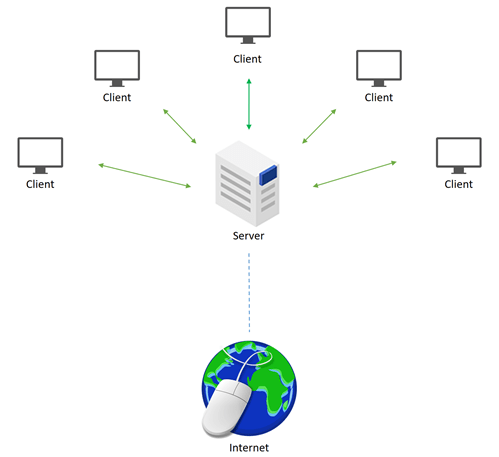Industry Insights at 7Clouds® Stay Connected with Industry Trends, Tips and News
dVPNs: Network Security with Decentralization

We’ve been hearing a lot about decentralized internet recently with Tachyon’s decentralized internet protocol and Brave’s VPN0. So, this week, we’re diving into decentralized (or distributed) virtual private networks (dVPNs), what they are, and how can they help enterprises connect to the internet more securely.
VPNs vs dVPNs: The problem with centralization
In the typical VPN model shown below, clients (users) connect to the internet by first going through a VPN server via an encrypted tunnel. This makes it appear as though the message of the client is coming from the VPN service provider location, masking their identity and information from anyone potentially monitoring the network connection. It also serves as an important security tool to allow all users of a corporation to connect to the internet via the same server.

A dVPN model has no central authority. Instead, a client also serves as a relay/exit node in a Peer-to-peer (P2P) network by using a portion of a client’s upload bandwidth to carry traffic for other clients on the network. In other words, each client can act as a VPN server to which other clients on the network can securely connect in order to access the internet. This is outlined below.

VPNs remain vulnerable to the very attacks they aim to protect their users against. In fact, an important issue with the centralization of typical VPNs is the possibility that data is logged as it goes through the VPN tunnel. Placing this amount of control into the hands of a single, central party can pose a threat to enterprise data.
dVPN security
Decentralizing this control makes it so that every individual client, or node, in a P2P network must be vulnerable to a threat in order for the threat to affect the network. As a result, it becomes more difficult to exploit the vulnerabilities of a dVPN than a typical VPN. And, with Blockchain technology on the rise, chronologically and cryptographically linking events across a network, the decentralization trend is just beginning.
7Clouds - Contact us today to discuss how decentralization can help your business achieve its security goals.

References
Brave, VPN0: A Privacy-Preserving Distributed Virtual Private Network. October 2019.
IBM, What is blockchain activity? 2019.
Kai Sedgwick, Why a VPN Is The First Layer You Should Pull On When Browsing The Web. October 2019.
Sara Joudrey, Your guide to Decentralized VPNs. November 2019.
Tachyon Protocol, 2020.
Tanvir Zafar, What Does a Decentralized VPN Look Like? December 2019.
Featured image: Pixabay
Tags
Latest Posts
Popular Posts
-
From SMEs to Families: Enterprise Virtualization Tips for Confinement with the Kids
From virtual machines to virtual workplaces, SME virtualization technology is securing its place in the family household as COVID-19 keeps us home. The shift towards...
-
7Clouds® Managed Services Yield Results
7CLOUDS Managed Services Yield ResultsDownload





Stay Connected With Industry Trends & News
Sign Up for Our Newsletter

